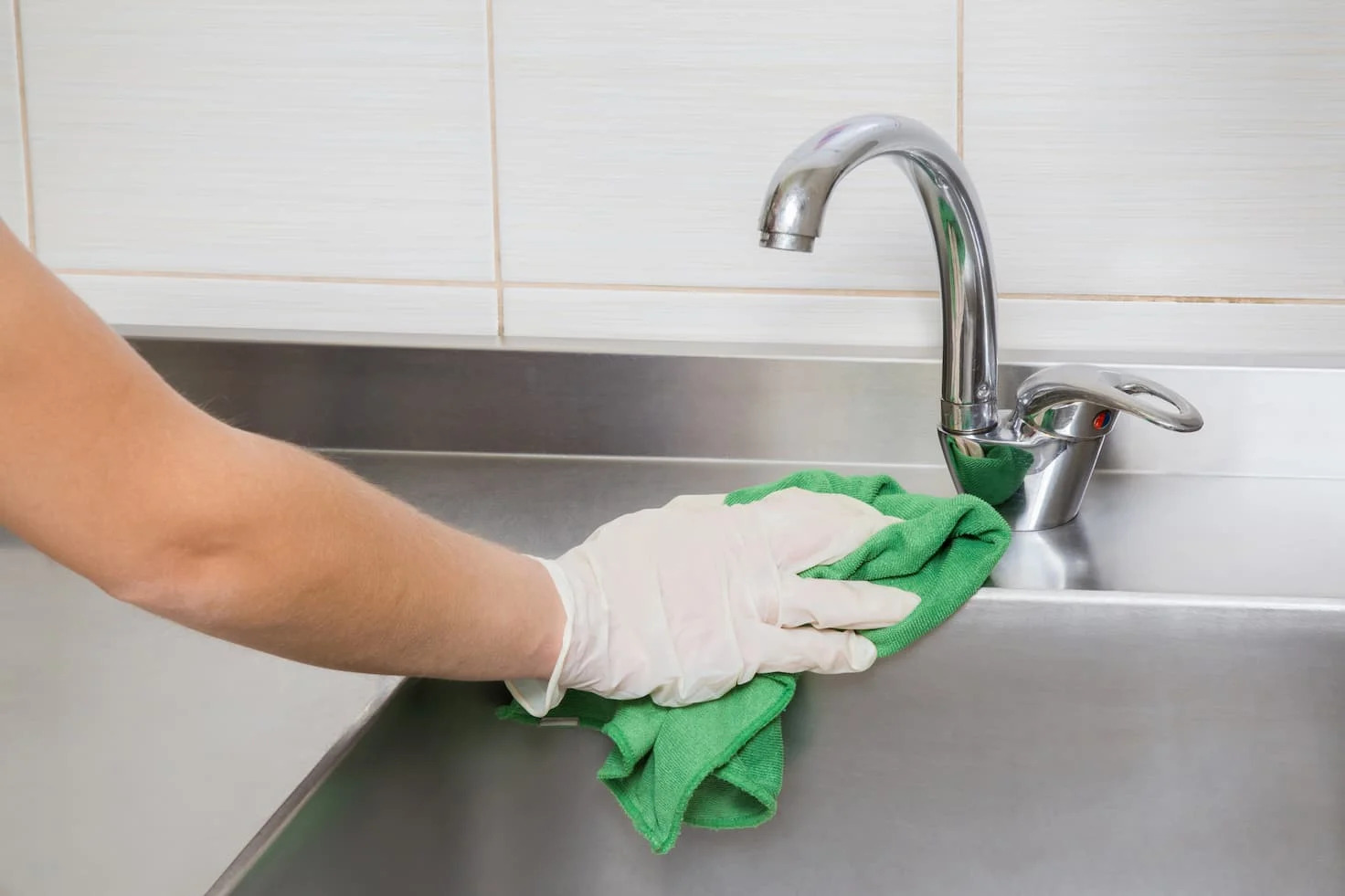Home>Kitchen & Cooking>Kitchen Gadgets & Utensils>How Should Flatware And Utensils That Have Been Cleaned And Sanitized Be Stored


Kitchen Gadgets & Utensils
How Should Flatware And Utensils That Have Been Cleaned And Sanitized Be Stored
Modified: February 17, 2024
Discover the best ways to store cleaned and sanitized kitchen gadgets and utensils for optimal hygiene and organization. Learn the essential tips for maintaining your kitchen tools.
(Many of the links in this article redirect to a specific reviewed product. Your purchase of these products through affiliate links helps to generate commission for Storables.com, at no extra cost. Learn more)
Introduction
Proper storage of cleaned and sanitized flatware and utensils is crucial for maintaining their cleanliness, ensuring food safety, and prolonging their lifespan. After undergoing thorough cleaning and sanitization, these essential kitchen tools must be stored correctly to prevent contamination and maintain their pristine condition. In this article, we will explore the best practices for storing flatware and utensils after they have been cleaned and sanitized, as well as common mistakes to avoid. By following these guidelines, you can uphold the highest standards of hygiene in your kitchen and preserve the quality of your flatware and utensils.
Key Takeaways:
- Properly storing cleaned utensils prevents contamination and damage, ensuring food safety and longevity. Air-dry, segregate by type, and avoid overcrowding to maintain cleanliness and efficiency in the kitchen.
- Neglecting thorough drying and mixing different utensils can lead to contamination and damage. Regular inspection and maintenance are crucial for safe and hygienic use.
Read more: How Should Flatware Be Stored
Importance of Proper Storage
Proper storage of cleaned and sanitized flatware and utensils is paramount for several reasons. Firstly, it plays a pivotal role in upholding food safety standards. When flatware and utensils are stored incorrectly, they are susceptible to contamination from environmental factors such as dust, airborne particles, and microorganisms. This can compromise the cleanliness of the utensils and pose potential health risks to consumers. By storing them properly, you can mitigate these risks and maintain a hygienic environment in your kitchen.
Furthermore, the longevity of flatware and utensils is directly influenced by how they are stored. Improper storage can lead to scratches, dents, and corrosion, diminishing the overall quality and aesthetics of the utensils. This not only affects their functionality but also necessitates frequent replacement, incurring unnecessary costs. By implementing appropriate storage practices, you can extend the lifespan of your flatware and utensils, ensuring that they remain in optimal condition for an extended period.
In addition to hygiene and durability, proper storage also contributes to the overall organization and efficiency of the kitchen. Well-organized storage systems facilitate easy access to utensils, streamlining food preparation processes and enhancing productivity in a culinary environment. This is particularly important in commercial kitchens where time is of the essence, and the seamless flow of operations is essential for customer satisfaction.
By recognizing the significance of proper storage, individuals and food service establishments can prioritize the maintenance of a clean, safe, and efficient kitchen. Implementing effective storage practices is a proactive measure that safeguards against potential health hazards, reduces unnecessary expenses, and fosters a conducive working environment. Therefore, it is imperative to adhere to best practices for storing cleaned and sanitized flatware and utensils to uphold the highest standards of hygiene and operational excellence.
Best Practices for Storing Cleaned and Sanitized Flatware and Utensils
-
Air Drying: After the cleaning and sanitization process, ensure that the flatware and utensils are thoroughly air-dried before storage. This helps to prevent the accumulation of moisture, which can lead to bacterial growth and tarnishing of the utensils. Utilize drying racks or designated drying areas with ample ventilation to facilitate the drying process effectively.
-
Segregation by Type: Categorize and store different types of flatware and utensils separately. This segregation prevents damage and minimizes the risk of cross-contamination. For instance, knives should be stored away from spoons and forks to avoid potential nicks and scratches, which can compromise their cleanliness and safety.
-
Utilize Drawer Organizers: Drawer organizers with compartments are ideal for storing flatware and utensils. They not only keep the items neatly arranged but also provide individual slots for each piece, preventing them from coming into contact with one another. This minimizes the likelihood of damage and simplifies the retrieval of specific utensils during food preparation.
-
Avoid Overcrowding: Ensure that the storage containers or drawers are not overcrowded with flatware and utensils. Overcrowding can lead to friction between items, causing scratches and abrasions. It also impedes easy access and retrieval, leading to unnecessary handling and potential contamination.
-
Consider Protective Sleeves: For delicate or specialty flatware, consider using protective sleeves or pouches for individual items. This extra layer of protection shields the utensils from dust, scratches, and other potential damage, preserving their quality and finish over time.
-
Elevate Storage Surfaces: When storing flatware and utensils in drawers or cabinets, consider using non-slip drawer liners or shelf liners. These liners not only prevent the items from shifting during movement but also protect them from hard surfaces, reducing the risk of dents and scratches.
-
Regular Inspection and Maintenance: Periodically inspect the stored flatware and utensils for any signs of damage, corrosion, or contamination. This proactive approach allows for the timely identification and rectification of any issues, ensuring that the utensils remain in optimal condition for safe and hygienic use.
By adhering to these best practices, individuals and food service establishments can uphold the cleanliness, safety, and longevity of their flatware and utensils, contributing to a well-organized and efficient kitchen environment.
Common Mistakes to Avoid
Improper storage of cleaned and sanitized flatware and utensils can lead to a myriad of issues, compromising hygiene, safety, and the overall quality of the kitchen tools. To maintain the integrity of the utensils and uphold food safety standards, it is crucial to be mindful of common mistakes that should be avoided when storing flatware and utensils.
Neglecting Thorough Drying
One of the most common mistakes is neglecting to ensure that flatware and utensils are thoroughly dried before storage. When utensils are stored while still damp, it creates an ideal environment for bacterial growth and tarnishing. This oversight can lead to potential contamination and compromise the cleanliness of the utensils.
Read more: How Many Sets Of Flatware Should I Have
Mixing Different Types of Utensils
Storing different types of utensils together without proper segregation is another prevalent mistake. Mixing knives, forks, and spoons in the same storage compartment can result in nicks, scratches, and damage to the utensils. Additionally, it increases the risk of cross-contamination, as different utensils may come into contact with one another, potentially compromising hygiene.
Overcrowding Storage Spaces
Overcrowding storage containers or drawers with flatware and utensils is a common error that can lead to damage and inefficiency. When utensils are crammed together, they are prone to friction, causing scratches and abrasions. Moreover, overcrowding impedes easy access and retrieval, leading to unnecessary handling and potential contamination.
Neglecting Regular Inspection
Failing to conduct regular inspections of stored flatware and utensils is a critical mistake. Without periodic checks, damage, corrosion, or contamination may go unnoticed, posing risks to food safety and the longevity of the utensils. Regular inspections are essential for identifying and addressing any issues promptly.
Using Improper Storage Containers
Using unsuitable or improper storage containers for flatware and utensils can also lead to detrimental consequences. Containers that are too small may cause overcrowding, while those that are too large can result in items shifting and bumping into each other during movement. Both scenarios can lead to damage and compromise the cleanliness of the utensils.
Ignoring Protective Measures for Delicate Utensils
Failing to provide protective measures for delicate or specialty flatware is a common oversight. Without protective sleeves or pouches, delicate utensils are vulnerable to scratches, tarnishing, and other forms of damage. Neglecting to implement these protective measures can diminish the quality and aesthetics of the utensils over time.
Inadequate Maintenance of Storage Surfaces
Neglecting to maintain storage surfaces, such as drawers and cabinets, can lead to damage to the stored utensils. Without non-slip liners or regular maintenance, utensils may shift, leading to dents and scratches. Inadequate maintenance of storage surfaces can compromise the integrity of the utensils and hinder efficient access.
By being mindful of these common mistakes and implementing appropriate storage practices, individuals and food service establishments can safeguard the cleanliness, safety, and longevity of their flatware and utensils, contributing to a well-organized and efficient kitchen environment.
Conclusion
In conclusion, the proper storage of cleaned and sanitized flatware and utensils is a fundamental aspect of maintaining a clean, safe, and efficient kitchen environment. By adhering to best practices for storage, individuals and food service establishments can uphold the highest standards of hygiene, mitigate potential health risks, and prolong the lifespan of their kitchen tools.
Effective storage practices, such as thorough air-drying, segregation by type, and the use of protective measures, contribute to the preservation of the cleanliness and quality of flatware and utensils. These practices not only prevent damage and contamination but also streamline food preparation processes, enhancing operational efficiency in culinary settings.
Furthermore, being mindful of common mistakes to avoid, such as neglecting thorough drying, mixing different types of utensils, and overcrowding storage spaces, is essential for safeguarding the integrity of the utensils and upholding food safety standards. Regular inspection and maintenance of storage surfaces also play a crucial role in ensuring that the stored utensils remain in optimal condition for safe and hygienic use.
By recognizing the importance of proper storage and implementing the recommended guidelines, individuals and food service establishments can create a kitchen environment that prioritizes cleanliness, safety, and operational excellence. This proactive approach not only minimizes the risk of contamination and damage but also contributes to cost savings by extending the lifespan of flatware and utensils.
In essence, the storage of cleaned and sanitized flatware and utensils is not merely a routine task but a critical component of upholding food safety standards and preserving the quality of essential kitchen tools. By embracing these best practices and avoiding common mistakes, individuals and food service establishments can foster a kitchen environment that is characterized by cleanliness, efficiency, and a commitment to excellence.
Frequently Asked Questions about How Should Flatware And Utensils That Have Been Cleaned And Sanitized Be Stored
Was this page helpful?
At Storables.com, we guarantee accurate and reliable information. Our content, validated by Expert Board Contributors, is crafted following stringent Editorial Policies. We're committed to providing you with well-researched, expert-backed insights for all your informational needs.














0 thoughts on “How Should Flatware And Utensils That Have Been Cleaned And Sanitized Be Stored”